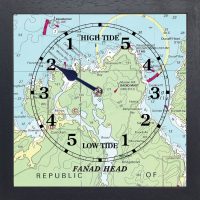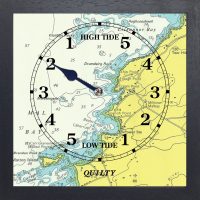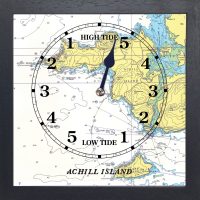Cushendun, or “Cois Abhann” in Irish, means “foot of the river,” perfectly describing this charming village nestled where the river meets the sea. Located north of Cushendall, on the stunning Antrim coast, it is ideal for nature lovers, walkers, and sea adventurers. The village blends coastal beauty with rich history, featuring sandy beaches, tidal flats, and serene river views. Whether fishing, hiking, or simply enjoying the fresh sea air, Cushendun offers a peaceful escape with unforgettable scenery.
The Cushendun map centers on the village, positioned where the coastal bay opens westward to the Irish Sea. To the west, the map reveals sandy shores with rocky headlands, particularly Cove Head and Torr Head. It shows piers and boat slips along the coast. Moving north, the map features the flowing river, tidal flats, and rocky beaches extending toward Downhill Point and Galboly.
East of the village, the map rises sharply to include Slieveanorra Mountain and surrounding rolling hills. The inland area displays forestry patches, freshwater loughs, and minor streams. Roads and trails weave through scattered settlements and farmland. To the south, the map shows expansive tidal marshes and coastal plains blending into rugged shorelines.
Other place-names on the map include Ballycastle Road, Cushendun Forest, Benbane, Turkrean, and Galboly.
A tide clock is a device that tells you if the tide is high or low, and how much time is left before it changes. It works by synchronising with the lunar cycle, which influences the tides. The tide clock has a single hand that rotates once every 12 hours and 25 minutes, which is the average time between two high tides or two low tides. The dial of the tide clock is divided into sections that indicate the state of the tide: high, low, rising, or falling. By looking at the position of the hand, you can tell what the tide is doing and how long it will take to change.
A tide clock can help you plan your activities around Cushendun by letting you know when the water is high enough or low enough for your preferred activity. For example, if you want to swim, you might want to avoid low tide, when the water is shallow and cold, and the mudflats are exposed. If you want to fish, you might want to avoid high tide, when the water is deep and fast, and the fish are dispersed. Going sailing, surfing, or kayaking? You might want to choose a time when the tide is rising or falling, which creates more favourable conditions for these sports. If you want to walk along the shore, you might want to choose a time when the tide is low, which reveals more of the beach and the wildlife.
A marine chart is a map of the sea and shoreline that shows water depths, hazards, and features you can use to understand the geography and infrastructure of a coastal location. It uses symbols and numbers to show how deep the water is at different places, where rocks, sandbanks, or wrecks are, and where channels are safer for boats. The chart marks landmarks on land—like lighthouses, piers, and headlands—so you can match what you see to the map.
The Cushendun Tide Clock contains full instructions on how to set and how to read a tide clock.
This is not a navigation device.

€65.00



“We received the tide clock this week and it is so fantastic, so beautiful! We love it. We just hit high tide on a full moon 5 min ago and I set it! Thank you thank you thank you and hope you are all doing well. I also was very excited to get a package from Ireland. That was half the fun!”
JF
“ I just received the tide clock that I ordered today, and I just wanted to say thank you! The service was so prompt, and the clock is amazing. It was great to find a gift for my husband who is very hard to buy for! He and my eldest daughter love to go fishing in the summer, so this will be very useful. Thanks again! .”
ML